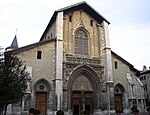Hôtel de Ville, Chambéry
1867 establishments in FranceBuildings and structures in ChambéryCity and town halls in FranceGovernment buildings completed in 1867Neoclassical architecture in France ... and 1 more
Pages with French IPA

The Hôtel de Ville (French pronunciation: [otɛl də vil], City Hall) is a municipal building in Chambéry, Savoie, southeastern France, standing on Rue Favre.
Excerpt from the Wikipedia article Hôtel de Ville, Chambéry (License: CC BY-SA 3.0, Authors, Images).Hôtel de Ville, Chambéry
Place de l'Hôtel de Ville, Chambéry
Geographical coordinates (GPS) Address Phone number Website Nearby Places Show on map
Geographical coordinates (GPS)
| Latitude | Longitude |
|---|---|
| N 45.5665 ° | E 5.9207 ° |
Address
Hôtel de ville de Chambéry
Place de l'Hôtel de Ville
73000 Chambéry
Auvergne-Rhône-Alpes, France
Open on Google Maps







